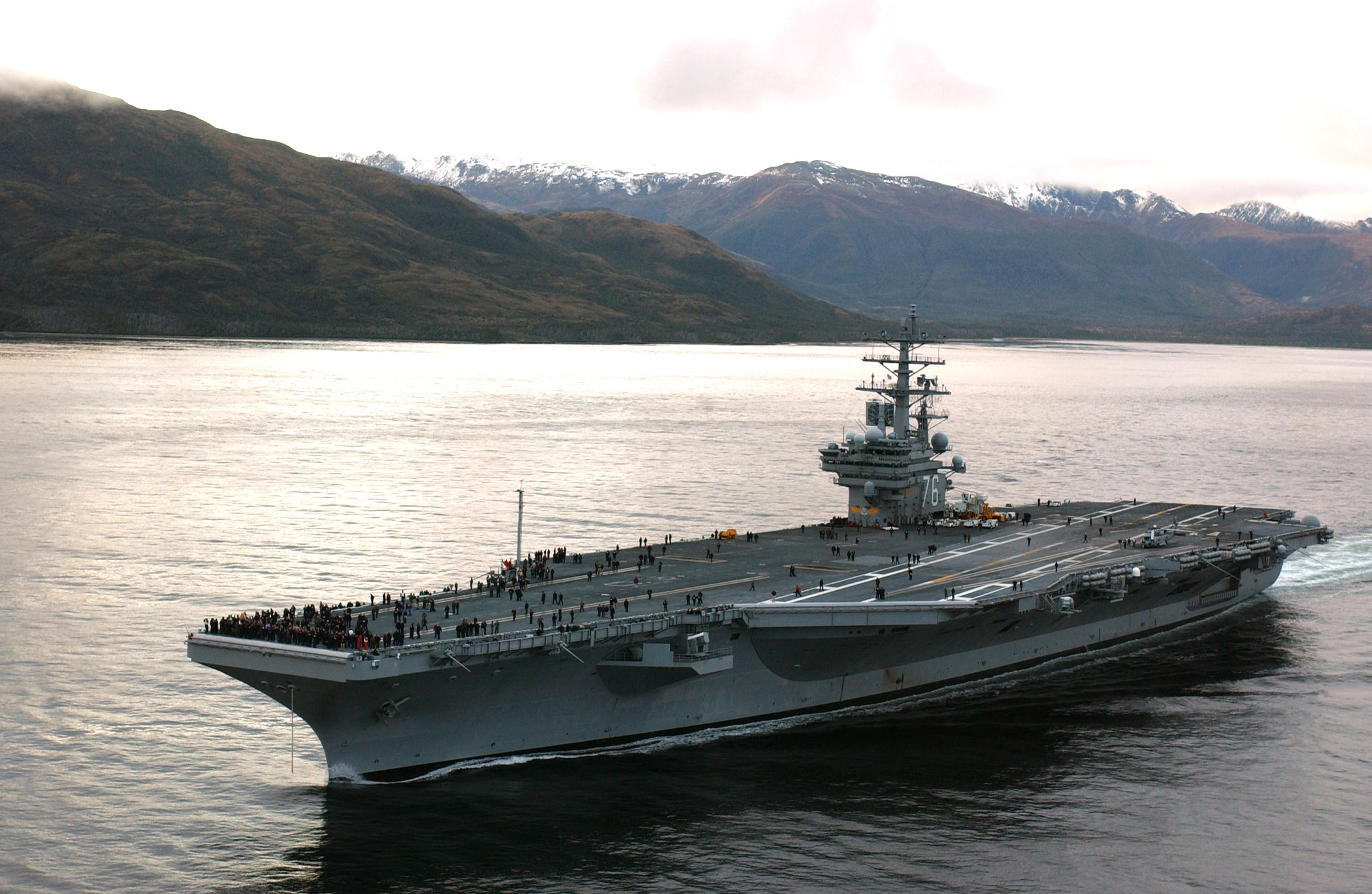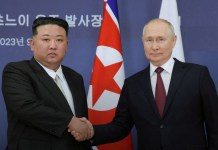In what appears to be a force projection in the region, a US aircraft carrier, the USS Carl Vinson, docked in Singapore this week when heightened tensions between The Philippines and China signal potential escalation.
It is not uncommon for US aircraft carriers to make port calls at Singapore, a traditional regional ally of the United States. The media was invited to cover the carrier strike group’s docking in Singapore. However, officials did not reveal where the nuke-powered war machine was headed.
The aircraft carrier Vinson was reportedly accompanied by ships from the United States “Carrier Strike Group One” fleet, comprising guided-missile destroyers and a missile cruiser. These ships are generally stationed in California when not sailing the world on operational missions.
“Questions of foreign policy and future operations, I would refer those questions to our higher headquarters,” Nikkei quoted Rear Adm. Carlos Sardiello as saying. “I can tell you Carrier Strike One has trained and rehearsed to be ready, both lethal and survivable, and we’re able to conduct our full range of operations in support of higher headquarters tasking.”
One of just 11 active aircraft carriers in the Navy, USS Carl Vinson is the third Nimitz-class nuclear-powered aircraft carrier based in San Diego, California. The vessel can carry around sixty assault fighter planes, helicopters, and other aircraft, all of which can take off and land on the carrier at sea.
Although United States officials described the latest docking as routine, the presence of the nuclear-powered aircraft carrier in the region comes at a precarious time. Tensions have escalated between US ally Philippines and China in recent months, with the latter reportedly confronting and bullying Filipino ships on missions to reinforce the disputed Second Thomas Shoal.
Since China claims almost the entirety of the South China Sea, it often carries out missions aimed at dissuading other claimants in the region from operating in the disputed territory. However, the confrontations between these two states, which were previously very far and few, have become more frequent in recent months.
A Chinese coast guard ship and a militia vessel bumped a Philippine coast guard ship and a military-run supply boat off a contested shoal, Philippine officials said. The flare-up heightens fears of a possible conflict in the disputed South China Sea. https://t.co/s0ciHaRBnN
— The Associated Press (@AP) October 22, 2023
In fact, in recent months, the Philippines Coast Guard (PCG) ships carrying out reinforcement missions for the military vessel have been attacked by the Chinese Coast Guard (CCG) ships, which often train water cannons on them.
The crisis came to a head in late October when a Chinese Coast Guard ship and an escorting vessel attacked a Philippine Coast Guard (PCG) craft and a military-run supply boat off a shoal that both parties claimed. In addition to these potentially violent exchanges, Beijing keeps peddling the narrative that Manila is inciting them.
Thus, the presence of a US carrier at this time has been interpreted as signaling to China. Days after Chinese vessels intimidated and obstructed the passage of Filipino Coast Guard ships in late October, US President Joe Biden reiterated his “ironclad” defense commitment to the Philippines. He warned Beijing that the US would come to the Philippines’ support in case of an attack in the South China Sea (SCS).
Earlier this month, during a resupply trip to BRP Sierra Madre, Philippine vessels were targeted by China Coast Guard (CCG) ships with water cannons, and one of them was rammed. After suffering severe damage from the Chinese high-intensity water cannon strike, one of the two supply boats, the ML Kalayaan, had to be pulled back to port.
After this, Chinese ships conducted a rare “invasion” of Second Thomas Shoal in the West Philippine Sea as a “calculated show of force by Beijing” after upsetting a Philippine resupply mission in the same waters, according to a maritime security expert. Up to eleven Chinese marine militia vessels were spotted in the Philippine-held shoal one day after the tense supply run.
Against that backdrop, the US carriers’ timing to make a statement by docking in the region is noteworthy. Singapore, for one, shares a cordial relationship with the US and is acquiring F-35 stealth jets from US defense giant Lockheed Martin.
However, the US carrier has not visited Manila recently, even though it has done so in the past. For instance, another Nimitz-class US aircraft carrier, USS Ronald Reagan (CVN 76), arrived in Manila in late October. At the time, the aircraft carrier was joined by Ticonderoga-class guided-missile cruisers USS Robert Smalls (CG 62) and USS Antietam (CG 54).
US Carriers Are Sailing Volatile Regions
It is typical of the US Navy to send its aircraft carriers, the backbone of its naval fleet, to volatile zones as a means of deterrence and power projection to its adversaries. The carriers sail far seas in peacetime but mainly during some tensions, as is currently evident in the SCS.
The last time a nuclear-powered aircraft carrier docked in Singapore was when the USS Nimitz made a port call in the Southeast Asian country in January. Before that, USS Ronald Reagan made a brief visit in July 2022, after which it quickly headed to the Philippine Sea to safeguard House Speaker Nancy Pelosi, who was in Taiwan in early August 2022.
In November, amid tensions over North Korea’s scheduled rocket launch of a space satellite, Carrier Strike Group One, a symbol of US military might and a nuclear-powered carrier, made a port stop in South Korea. The US aircraft carrier Carl Vinson arrived at a port in the South Korean city of Busan on November 21. It is likely that the carrier sailed to Singapore from there, although the US Navy stopped short of divulging these details.
However, US carriers often sail to the Indo-Pacific region, to the dismay of the People’s Liberation Army, which labels it provocative. For instance, USS Nimitz (CVN-68) and its strike group operated in the South China Sea in April before departing to the Philippine Sea in May. Following this, the Ronald Reagan Carrier Strike Group was seen working in the South China Sea in June 2023.

As part of the Indo-Pacific Command’s (INDOPACOM) Large Scale Global Exercise 2023 (LSGE23), the two carrier strike groups conducted drills with Japanese, French, and Canadian ships in the Philippine and East China Seas from June 7–10.
In late June, the USS Ronald Reagan carrier visited another Southeast Asian state, Vietnam. The aircraft carrier reportedly arrived in the central Vietnamese city of Danang a few weeks after a Chinese survey vessel, multiple Coast Guard ships and fishing boats sailed in Vietnam’s exclusive economic zone in the South China Sea.
The United States frequently dispatches its carriers to regions where its adversaries are aggressive and active. For instance, the George H.W. Bush Carrier Strike Group was deployed for eight months, and the Harry S. Truman Carrier Strike Group was deployed to the Mediterranean for nine months after the Russo-Ukraine War.
More recently, the USS Gerald R. Ford aircraft carrier strike group was dispatched to the Eastern Mediterranean to be stationed near Israel’s coast, just days after the country came under an unprecedented terror attack by Hamas on October 7. Another aircraft carrier strike group, USS Dwight D Eisenhower, joined the Ford just days later.
However, the presence of these carriers in the Indo-Pacific, especially in the contentious South and East China Seas, maybe the most significant since they irk regional giant China and reinforce the message that the latter’s regional adversary has Washington’s support.
- Contact the author at sakshi.tiwari9555(at)gmail.com
- Follow EurAsian Times on Google News




